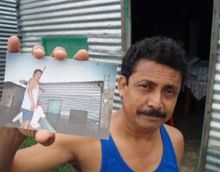April 25, 2008 Ostuacan, Chiapas, Mexico…Ansel Oliver/ANN
Carolina Hernandez Cruz doesn't go to school anymore.
She's suffering post-traumatic stress after losing her father and two sisters in a landslide during last year's flooding in Southeast Mexico, one of the worst disasters in the nation's history.
The 17-year-old remembers wanting to be a lawyer when she grew up. Now Cruz spends her days as a cook for surviving residents of her village living in camps of government-built wooden shelters. She's stumped when asked seemingly simple questions, such as “What do you like to do?” and “What are your hobbies?”
“I've seen this before,” says her pastor, Atanacio Ramirez Ramirez, 36, speaking through a translator. “People can for awhile lose interest in personal development.”
Ramirez has suffered his own hardships ministering after the disaster destroyed four of his 15 churches and killed 14 of his nearly 200 members.
“It was sad and difficult at the same time,” Ramirez recalls. “I couldn't attend all the funerals. Some were held simultaneously.”
Despite grief and loss, Seventh-day Adventist Church leaders here and in surrounding regions say a curious thing has happened in the six months since: attendance, giving and spiritual commitment has increased, mirroring the generous mood then seen throughout the nation. This district's “thank offering” was up this year 16 percent from last.
“This is something we can't explain,” says Felipe Dominguez, communication director for the church in the Southeast state of Tabasco, which experienced similar generosity.
“How come people without jobs were still able to be so generous?”
While some smaller affected communities, having lost everything, are still suffering, others have recovered or are rebuilding. And amid all this, church officials can't help but notice that approval for an Adventist university in Villahermosa is now faster in coming, five years after the necessary applications were submitted. Community involvement during the disaster helped the Protestant denomination gain such a school in the state, church leaders there say.
“The church here in Tabasco has a history of helping people in the community,” says Hebar Garcia, the church region's president. “We've invested in a mobile clinic and were able to help during that time,” he says, acknowledging help from church administrative regions nearby and overseas.
Along with many national organizations, the Adventist Church received special recognition for its relief efforts, which included well-run shelters and mobile clinics staffed with volunteer physicians, many of them medical students from the church's Montemorelos University in Northeast Mexico.
On a recent afternoon in Villahermosa, some locals are all too eager to point out water mark stains from when 80 percent of the state of Tabasco lay submerged, in some areas for as long as a month. Heavy rains in October coupled with full dams caused flooding and landslides. Sandbags stacked as high as 10 feet still cover hundreds of yards of sidewalks, even blocking bus stop shelters.
In Juan de Grijalva, church member Teodoro Sánchez Morales stands on a concrete slab next to the still swollen Grijalva River. “This used to be my house,” the 57-year-old says. His father died in the landslide. Nearby, workers in trucks, backhoes and bulldozers chip away at the mountains of dirt that still partially block the river.
The needs for this community now are housing and water, says Ramirez, the district's pastor. “They have potable water but it tastes horrible,” he says.
He says his members also want the feeling of being settled again. “They want to know, this is my house, this is my life, I'm here.”
Earlier that day, while standing on a hill overlooking the destroyed town, Ramirez pointed down the valley and across the river to a barely visible yellow dot.
“That's the church,” he said.
“How did it get there?” a visitor asked.
“It used to be up there,” he says pointing up the river. “But it was swept downstream about 100 yards.”
About 30 surviving residents of the town gathered that morning at the Ostuacan Adventist Church near their camp of wooden shelters to share their experiences during the tragedy. A young girl walked up the center aisle and handed a tissue to a woman shuddering with grief.
“I'm thankful to all the nations and the church for their help,” said Maria Guatalupe Cruz, 34, the mother of Carolina, who is suffering post-traumatic stress. Maria lost her husband and two children in the disaster.
“All we have to live on now is generosity.”
— Raul Lozano contributed to this story

